
 by Steven D. Johnson
by Steven D. Johnson
Racine, Wisconsin
This month:
•
Leadlight Window Frame
•
The Dust Free Knockdown Easy-To-Build Finishing Enclosure
•
Showdown! Two Universal Woodworking Products Go Head-To-Head
•
More Space & Time In Your Shop.
Building A Leadlight Window Frame
Click on any picture to see a larger version.
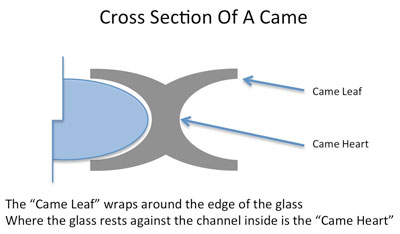
|
|
Figure 1 - Anatomy of a stained glass window "came"
|
Stained glass and leadlights are different products, but the terms have been used interchangeably… in fact, stained glass has, for all intents and purposes, become the common name for both. Both are made by encasing the edges of separate pieces of glass in "H" shaped soft metal cames. The cames can be made of lead, brass, copper, brass-capped lead, or zinc. The cames are soldered together where they meet so that the design of separate pieces of glass and the caming come together to form a single panel. Surrounding the entire panel is a "U" shaped piece of metal known as the border came. If the panel is intended to be free-hanging, a stiffer metal is typically used for the border came… if the panel is to be encased in a frame, such as for a window, the border came can be made of the same soft material used within the field of the panel.
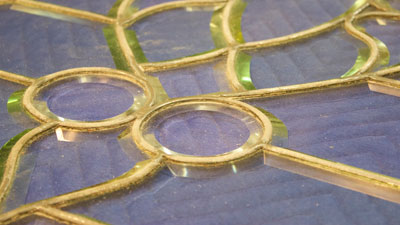
|
Figure 2 - Brass-capped lead cames and clear
but "greenish" colored glass
|
The basic construction techniques and caming, however, are where the similarities end between stained glass and leadlight. True stained glass is made of individual pieces of specifically shaped and colored glass. Colors can be produced by painting the glass and re-firing it. The color literally "melts into" and becomes an integral part of the glass. Chemicals or minerals can also be added to the original melted glass to impart color. Stained glass designs tend to be more intricate and often depict scenes, tell a story, or venerate an historical or religious figure or event. Stained glass is a work of art, handmade by artisans. And it is significantly more expensive than leadlights.
Leadlights are typically made from glass cast in a finite set of specific shapes, is likely to be clear (or as nearly clear as the period manufacturing limitations allowed) or very limited in the number of colors. Leadlights represent a simpler design aesthetic, (often with repeating designs or geometric shapes) and while most were handmade, even a hundred years ago leadlights were "handmade" in factories… not by artisans, but by trained factory workers… by the hundreds or even thousands. Someone once said that leadlights are the "poor man's stained glass."
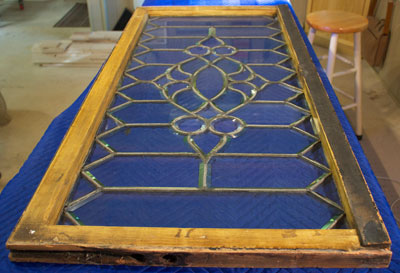
|
|
Figure 3 - Prior to removing sash/frame
|
It is thus more befitting that a Down To Earth Woodworker would come to acquire an 80 to 90 year-old leadlight … not a stained glass one-of-a-kind. It was undoubtedly made by hand, but equally undoubtedly it was mass-produced. It is pretty, but it is not a work of art. It is, truly, a poor man's stained glass "wannabe."
We looked for a long time to find a leadlight in our price range and sized correctly. The intent is to remove the existing frame, make a new frame, and hang the leadlight in a large picture window to break up the space a bit and add some visual interest.
The sketchy provenance I received indicates that the window, in its original frame, was sold in 1971 to a gentleman from whose son I purchased it forty-three years later. I haggled over the price, with a degree of success, but still probably overpaid. If I use a reverse-inflation calculation based on the price I paid, the father might have paid about $65 in 1971 for this used piece of glass… and I would guess he paid much, much less than that.
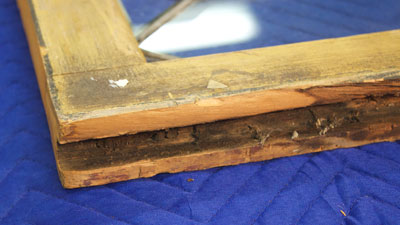
|
|
Figure 4 - Up close, the sash was in really bad shape
|
The son claims it came from a hospital window. Perhaps. It could have come from a school or a library, too, but more probably it came from a residence. In the mid- to late-1800's leadlights were quite popular, particularly around the entrance to a home, either as sidelights to a door, as transom windows, or even stairway windows. The Arts & Crafts movement enhanced the popularity of leadlights, but the Arts & Crafts leadlights made then usually contained flower motifs. In the 1920s and 30s many houses had mock Tudor elements with relatively plain diamond-pane leadlight windows and these same styles of leadlight windows also made their way into Bungalow Style homes. Both Arts and Crafts and Bungalow Style homes are prevalent in this area, so I would guess the window is some 80 – 90 years old and from a modestly priced house.
All of this, of course, is just mental meandering as I work to remove the existing frame and prepare for building a new frame for the leadlight. The window frame was built with a rabbet to hold the glass on one side, and nails held the leadlight in place tight against the rabbet. The nails were hand-hammered, a fact supported by the randomness of both spacing and angle, and the fact that several of the nails actually went through the lead border caming around the window.
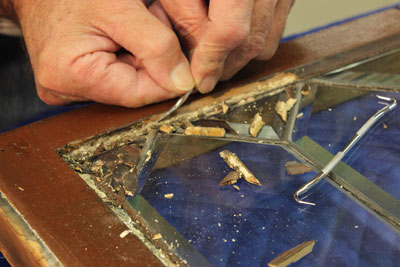
|
Figure 5 - Tedious work removing generations
of caulk and paint
|
The original maker had applied some type of caulking over the nailed side of the window. That caulking was augmented, layer-upon-layer, over the years, and painted numerous times, too. Mostly I used dental picks and a small chisel to remove the bone-dry caulking; then used a jeweler's screwdriver, a pair of forceps, and a small pair of needle nose pliers to remove the nails.
There is no abject damage, but there is a distressing amount of subtle damage. In several places where nails went through the border caming, the caming is broken, thus weakening the entire panel. There is also a tiny hole where a small corner of glass is chipped. Some of the caming is quite loose. As I have written before, I am fortunate to have a fellow coffee-lover next door. On the other side, my neighbor's hobby is making stained glass. Good fortune has once again tapped my shoulder, and I will tap into her expertise to repair the caming.
Because leadlight glass pieces are inherently weak, and because the piece is rather large (47" X 21") I originally intended to build the frame of hard maple. While at the lumberyard, spouse accompanying, she fell in love with some leopardwood and changed my mind about the maple. Personally, I have more of a love/hate relationship with this particular genus.
No doubt leopardwood is a beautiful and interesting wood. I used it several years ago to top a table for a friend. But the large medullary rays that give the leopard its spots, also make the wood difficult to work without tearout. It is a dense and heavy wood, and it can provoke allergic reactions with some people. Extra precautions are de rigueur.
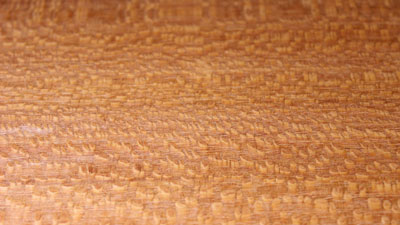
|
Figure 6 - Roupala (leopardwood) is hard and dense,
and the highly figured grain is hard to work without tearout
...but it IS beautiful!

|
My hardwood supplier stocks rough-cut hard and soft maple, ash, walnut, and more, and I am quite accustomed to buying 8/4, 10/4, and even 12/4 stock. The near-perfectly quartersawn leopardwood is already surfaced to about 7/8" thick… not nearly thick enough for the frame I envisioned. I am opposed to glue lines or other obvious indications that I "beefed up" the thickness of the wood, so I will be cutting the stock with 45-degree edges and boxing the pieces to achieve the thickness I want. This method produces a heart-breaking amount of waste, but it is for a good cause.
Originally I had envisioned a frame made with through-tenons and drawbore pins. I may change to a housed tenon and use walnut for the pins. Walnut looks good with Leopardwood and I happen to have a half a chunk of black walnut log and a sharp axe, so I think I can make some really strong straight-grain pins. By next month I should have this project well under way… unless my spouse finds another, more pressing project that moves to the top of the list.
(Page 1 of 4)
1
2
3
4
Next Page
Return to
Wood News
front page

